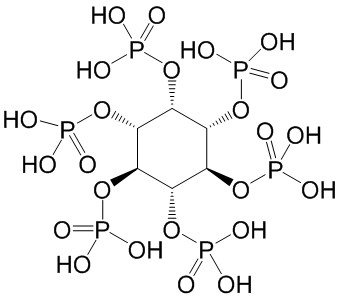Home
Products
Phytic acid



| Product Name | Phytic acid |
| Price: | $15 / 20mg |
| Catalog No.: | CN06711 |
| CAS No.: | 83-86-3 |
| Molecular Formula: | C6H18O24P6 |
| Molecular Weight: | 660.04 g/mol |
| Purity: | >=98% |
| Type of Compound: | Miscellaneous |
| Physical Desc.: | Oil |
| Source: | The herbs of Oryza sativa |
| Solvent: | DMSO, Pyridine, Methanol, Ethanol, etc. |
| SMILES: | OP(=O)(O[C@@H]1[C@H](OP(=O)(O)O)[C@H](OP(=O)(O)O)[C@H]([C@@H]([C@H]1OP(=O)(O)O)OP(=O)(O)O)OP(=O)(O)O)O |
| Contact us | |
|---|---|
| First Name: | |
| Last Name: | |
| E-mail: | |
| Question: | |
| Description | Phytic acid is a major phosphorus storage compound of most seeds and cereal grains. |
| Target | Human Endogenous Metabolite |
| In Vitro | Phytic acid, a major phosphorus storage compound of most seeds and cereal grains, contributes about 1 to 7% of their dry weight. It may account for more than 70% of the total kernel phosphorus. Phytic acid has the strong ability to chelate multivalent metal ions, especially zinc, calcium, and iron. The binding can result in very insoluble salts that are poorly absorbed from the gastrointestinal tract, which results in poor bioavailability of minerals. Phytic acid is also considered to be a natural antioxidant and is suggested to have potential functions of reducing lipid peroxidation and as a preservative in foods[1]. Phytic acid inhibits the formation of uric acid from xanthine with an IC50 of about 30 mM. The generation of the superoxide is greatly affected by phytic acid; the IC50 is about 6 mM, indicating that the superoxide generating domain of XO is more sensitive to phytic acid[2]. There has been observed an inhibition of tumor growth and induction of cell differentiation in the presence of phytic acid in a few cancer cell lines including colon, nipple, breast, prostate, cervix, liver, pancreas, melanoma and glioblastoma[3]. |
| In Vivo | Phytic acid has a neuroprotective effect in MPTP-induced PD model and the neuroprotection is correlated with its anti-inflammatory effect which may be associated with suppression of pathways that involved in NF-κB and p-ERK. Phytic acid significantly inhibits MPTP-induced dopaminergic cell loss in the substantia nigra (SN). Moreover, using immunohistochemistry method and quantitative polymerase chain reaction (qPCR), microglial activation and inducible nitric oxide synthase (iNOS) are found to be markedly repressed by phytic acid[4]. |
| Animal Admin | Mice: MPTP (20 mg/kg/day, i.p.) is administrated for 5 days and animals are killed at 7 days later. Phytic acid (30 mg/kg/day, i.p.) or normalsaline is injected 4 days before MPTP administration and con-tinued until mice are killed, reaching a total treatment period of16 days[4]. |
| Density | 2.4±0.1 g/cm3 |
| Boiling Point | 1190.7±75.0 °C at 760 mmHg |
| Flash Point | 673.9±37.1 °C |
| PSA | 459.42000 |
| LogP | -8.47 |
| Vapour Pressure | 0.0±0.6 mmHg at 25°C |
| Storage condition | Refrigerator |